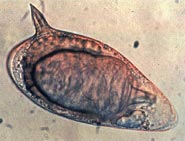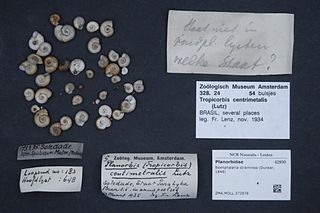
Schistosoma is a genus of trematodes, commonly known as blood flukes. They are parasitic flatworms responsible for a highly significant group of infections in humans termed schistosomiasis, which is considered by the World Health Organization as the second-most socioeconomically devastating parasitic disease, with hundreds of millions infected worldwide.
Schistosoma japonicum is an important parasite and one of the major infectious agents of schistosomiasis. This parasite has a very wide host range, infecting at least 31 species of wild mammals, including nine carnivores, 16 rodents, one primate (human), two insectivores and three artiodactyls and therefore it can be considered a true zoonosis. Travelers should be well-aware of where this parasite might be a problem and how to prevent the infection. S. japonicum occurs in the Far East, such as China, the Philippines, Indonesia and Southeast Asia.

Oncomelania is a genus of very small tropical freshwater snails, aquatic gastropod mollusks in the family Pomatiopsidae.

Schistosoma malayensis is a schistosome parasite. It was first described in 1988 in Peninsular Malaysia and appears to be a zooenotic infection. The species is named after the country of Malaysia. The natural vertebrate host is van Müller's rat. The intermediate hosts are aquatic snails, Robertsiella kaporenisis. Among Robertsiella kaporenisis are two other Roberstiella species.

Eomecon is a monotypic genus of flowering plants in the poppy family containing the single species Eomecon chionantha. Its common names include snow-poppy and dawn-poppy. It is native to China.
Tricula is a genus of freshwater snails with a gill and an operculum, aquatic gastropod mollusks in the family Pomatiopsidae.

Pomatiopsidae is a family of small, mainly freshwater snails, that have gills and an operculum, aquatic gastropod mollusks in the superfamily Truncatelloidea.

Neotricula aperta is a species of freshwater snail, an aquatic gastropod mollusk in the family Pomatiopsidae.

Freshwater snails are gastropod mollusks that live in fresh water. There are many different families. They are found throughout the world in various habitats, ranging from ephemeral pools to the largest lakes, and from small seeps and springs to major rivers. The great majority of freshwater gastropods have a shell, with very few exceptions. Some groups of snails that live in freshwater respire using gills, whereas other groups need to reach the surface to breathe air. In addition, some are amphibious and have both gills and a lung. Most feed on algae, but many are detritivores and some are filter feeders.

Biomphalaria straminea is a species of air-breathing freshwater snail, an aquatic pulmonate gastropod mollusk in the family Planorbidae, the ram's horn snails.

Biomphalaria sudanica is a species of air-breathing freshwater snail, an aquatic pulmonate gastropod belonging to the family Planorbidae, the ram's horn snails. Biomphalaria sudanica has a discoidal, brown shell with an approximate shell diameter of 9–11mm. Biomphalaria sudanica is a medically important pest, due to it being an intermediate host of the intravascular trematode genus, Schistosoma.
Tricula hortensis is a species of freshwater snail with a gill and an operculum, an aquatic gastropod mollusk in the family Pomatiopsidae.

Blanfordia is a genus of terrestrial gastropod mollusks in the family Pomatiopsidae. They are land snails which have an operculum.

Fukuia integra, also known as Blanfordia integra, is a species of land snail which has an operculum, a terrestrial gastropod mollusk in the family Pomatiopsidae.
Erhaia is a genus of small to minute freshwater snails with a gill and an operculum, aquatic gastropod mollusks in the family Amnicolidae.

Neotricula is a genus freshwater snails which have a gill and an operculum, gastropod mollusks or micromollusks in the family Pomatiopsidae.
Neoprososthenia is a genus of freshwater snails with gills and an operculum, aquatic gastropod mollusks in the family Pomatiopsidae.

















